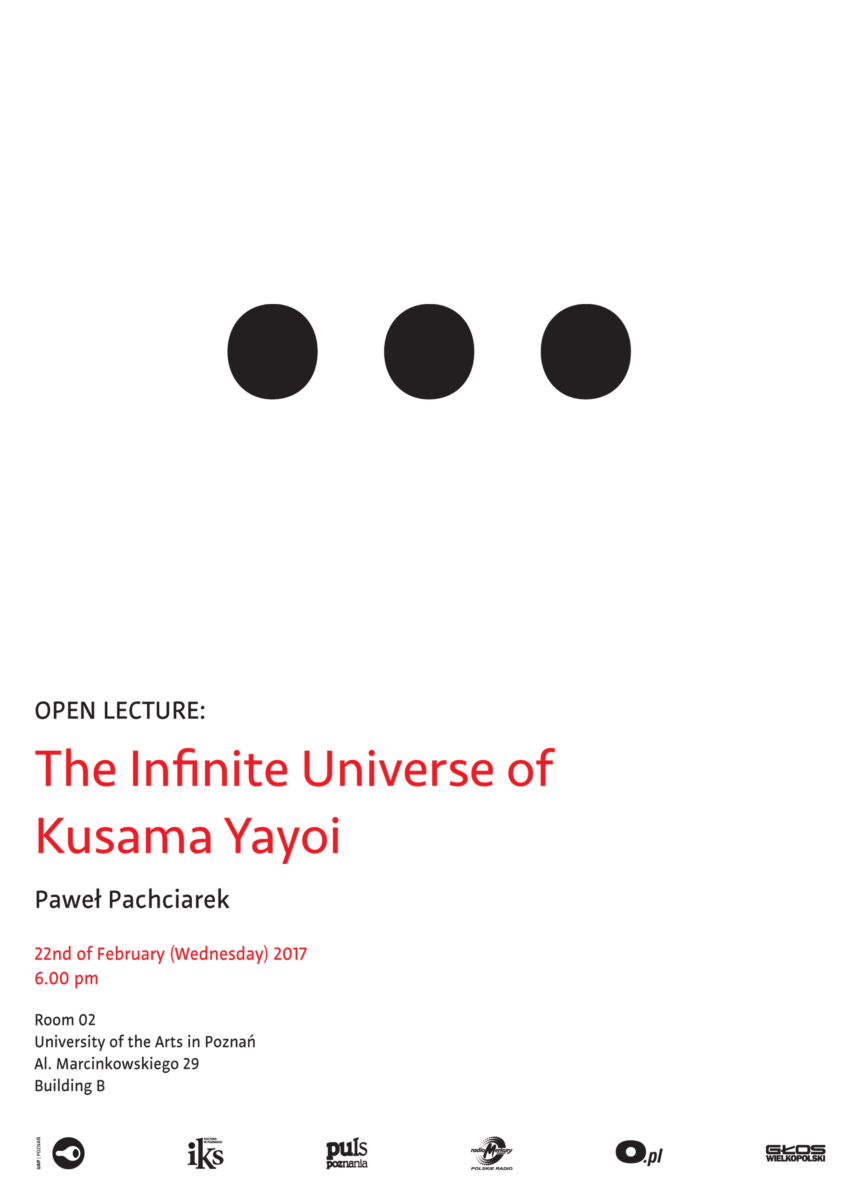Open lecture: The Infinite Universe of Kusama Yayoi
22nd of February (Wednesday) 2017
6.00 pm.
Building B, Room 02
University of the Arts in Poznań
Al. Marcinkowskiego 29
Dear Sirs,
We would like to invite You for the first open English lecture in this semester in University of the Arts Poznan. This year Open Lecture cycle is dedicated to artistic and social-symbolic culture.
About author:
Pawel Pachciarek
PhD Candidate, Adam Mickiewicz University, Poland. MEXT Scholarship Program, Osaka University
In 2013 he received Japan Foundation Fellowship to conduct a research on Yayoi Kusama’s literary art at Osaka University. From 2015 to 2016, he continued his work at Doshisha University in Kyoto. From April, this year he was granted a scholarship from Japanese Ministry of Education, Culture, Sports, Science and Technology: MEXT, to start another research at Osaka University. He specializes in Japanese Contemporary Art and Literature.
Yayoi Kusama – Dots Obsession (Abstract)
Yayoi Kusama (born 1929) is a Japanese artist and writer whose literary output implicitly refers to the traditions of Japanese art on the one hand, and yet on the other fits in the mainstream of the Western trans-avant- garde from the late 1960s and early 1970s.
What makes Yayoi Kusama stand out is her specific approach to the art of creation. It is a state of concentration verging on meditation, during which temporal presence becomes abolished or dispersed. This is when the pieces characterised by simplicity of the means employed and apparent schematism are composed. Tosa Mitsuoki (1617-1691), a master of the traditional school of Japanese tosa painting, described this art as reaching into the deep recesses of the human heart. Kusama blends this approach in an eclectic communion with a condition expressed “in the metaphor of labyrinth, the dispersion of entity, nomadism” – a grand melting pot of the said trans-avant- garde. Such art possesses the capacity to simultaneously depict a multitude of paths of entry and exit, which would make it possible to live in a world deprived of grand stories, and a history that would weave an infinite number of narratives into one fabric. The nomadic character of the artist’s works is brilliantly captured by Achillo Bonito Oliva: Tin nomadic works, the art of the 1970s comes across own excellent movement coupled with the ability to traverse all territories freely without any hindrance, while following the guidelines which keep opening them up in all directions”.
In progress since the 1990s, the process of rediscovering the art of Yayoi Kusama, an icon of social and cultural transformations, “the Queen of the hippies” and the progenitor of such movements as pop-art or minimalism (to name a few), who fell into oblivion outside Japan, has been further contributing to a redefinition of the significance of the work of the author of Infinity Nets in the context of the history of art. What is more, this process, known as the “Kusama renaissance”, brings with it a line-up of retrospective exhibitions along with exhibitions of her most recent work on display in key galleries and museums around the world.
The activities she launched in pursuit of her utopian vision met with a lack ofunderstanding for a long time. This is how Kusama explains the social isolation or frequent fits of obsessive neurosis driven by this isolation: Suffering is inherent to those who are avant-garde in the society. Many a time has the author of Self-Obliteration underscored that she has no regrets about the path entirely devoted to art that she has taken. Intent on setting far-reaching plans since early childhood, she has never veered from this course; despite many constraints she keeps crafting art which, as it seems, will never fail to dazzle.

- Autor: Aleksandra Gaj
- Opublikowano: 21.02.2017, 22:46
- Ostatnia edycja: 03.01.2023, 23:00

